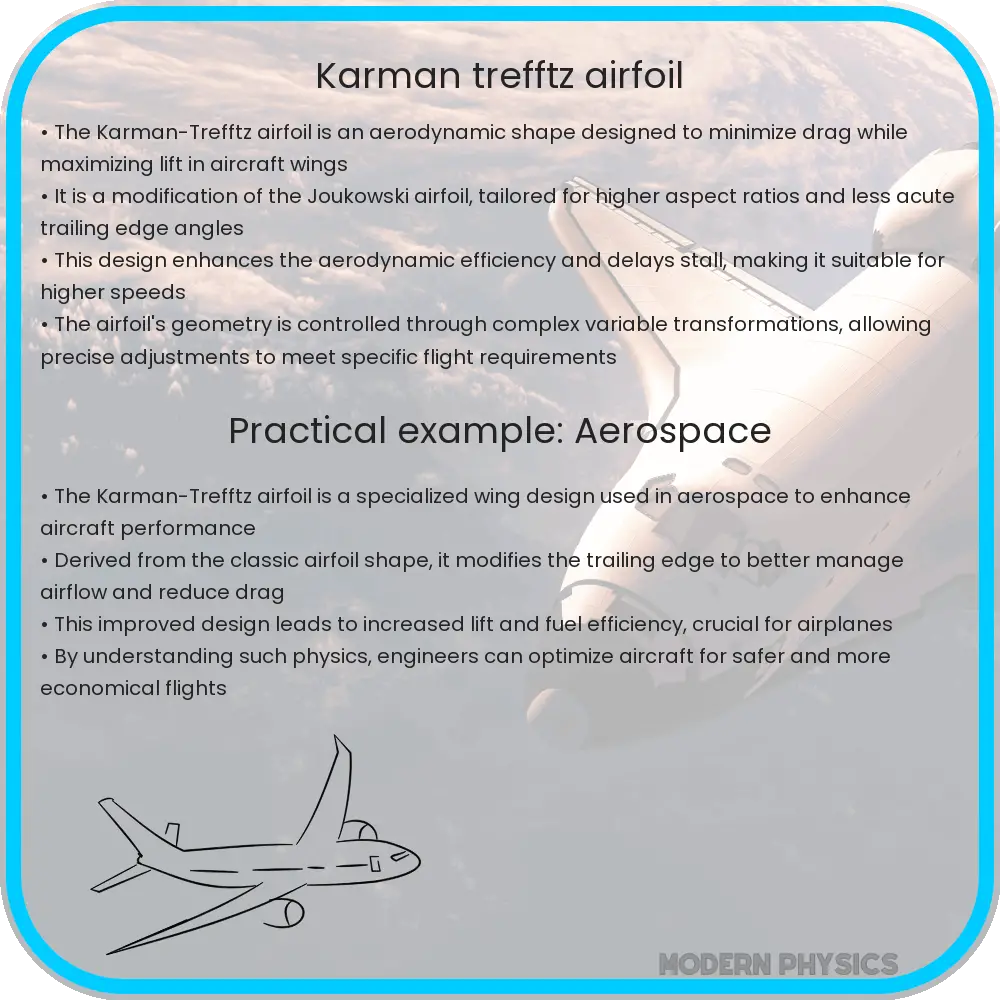Explore the efficient Karman-Trefftz Airfoil: its design, flow characteristics, aviation and renewable energy applications, and future prospects.

Understanding the Karman-Trefftz Airfoil: Principles and Applications
The Karman-Trefftz Airfoil represents a significant advancement in aerodynamic design, offering improved efficiency and flow characteristics over traditional airfoil shapes. This innovative design is a variant of the classic Joukowski airfoil and is named after Theodore von Kármán and Erich Trefftz, who contributed significantly to its development.
Efficiency of the Karman-Trefftz Airfoil
One of the key features of the Karman-Trefftz airfoil is its enhanced efficiency. This is primarily due to its unique shape, which minimizes drag while maximizing lift. The airfoil’s curvature and trailing edge are optimized to reduce vortex formation and wake turbulence, leading to a smoother airflow and greater aerodynamic efficiency. This improvement is particularly noticeable in high-speed applications, where drag reduction plays a crucial role in performance.
Flow Characteristics
The flow around a Karman-Trefftz airfoil is markedly different from that around traditional airfoils. It exhibits a more uniform pressure distribution, which contributes to its stability and control. This characteristic is essential for aircraft maneuverability, especially during high-speed or complex maneuvers. The airfoil’s design also ensures a laminar flow over a more significant portion of the surface, reducing the likelihood of flow separation and the associated drag.
Design Considerations
Designing a Karman-Trefftz airfoil involves several critical considerations. Firstly, the airfoil’s shape must be tailored to the specific application, taking into account factors like the Mach number, Reynolds number, and angle of attack. Computational fluid dynamics (CFD) simulations play a vital role in this process, allowing designers to predict and optimize the airfoil’s performance in various conditions. Material selection is another crucial aspect, as the airfoil must withstand the physical stresses encountered during operation without significant deformation.
In conclusion, the Karman-Trefftz airfoil represents a leap forward in aerodynamic efficiency and performance. Its unique design offers reduced drag, enhanced lift, and improved flow characteristics, making it a valuable asset in both aviation and wind turbine applications. As technology advances, we can expect further refinements in airfoil design, building upon the foundational principles established by the Karman-Trefftz airfoil.
Applications of the Karman-Trefftz Airfoil
The versatility of the Karman-Trefftz airfoil extends to various fields, most notably in aviation and wind energy. In aviation, this airfoil is ideal for high-speed aircraft due to its ability to maintain efficient performance at different flight conditions. Its enhanced lift-to-drag ratio contributes to fuel efficiency, a crucial factor in commercial and military aviation. In wind energy, the airfoil’s efficiency translates into improved performance of wind turbines, particularly in regions with variable wind speeds.
Advancements in Computational Methods
Recent advancements in computational methods have furthered our understanding and optimization of the Karman-Trefftz airfoil. With the advent of more powerful computing resources, engineers can now simulate complex flow scenarios with greater accuracy. These simulations facilitate the exploration of innovative design modifications, potentially leading to even more efficient airfoil profiles. Moreover, they enable the prediction of aerodynamic performance in extreme conditions, enhancing safety and reliability.
Environmental Impact
The environmental impact of adopting the Karman-Trefftz airfoil in various applications cannot be overstated. In aviation, the improved efficiency leads to lower fuel consumption and reduced greenhouse gas emissions. In the realm of renewable energy, the airfoil’s effectiveness in wind turbines supports the shift towards sustainable power sources, mitigating the effects of climate change.
Future Prospects
The future of the Karman-Trefftz airfoil is intertwined with the ongoing pursuit of sustainability and efficiency in aerospace and renewable energy sectors. Continuous research and development are expected to refine its design further, exploiting new materials and manufacturing techniques. The integration of smart technologies, such as adaptive materials that can change shape in response to aerodynamic conditions, holds promise for the next generation of airfoil designs.
Conclusion
In conclusion, the Karman-Trefftz airfoil stands as a testament to the synergy of aerodynamic theory and practical engineering. Its efficiency, enhanced flow characteristics, and adaptability make it a cornerstone in modern aerodynamic design. As we look to a future where efficiency and environmental sustainability are paramount, the principles and applications of the Karman-Trefftz airfoil will undoubtedly continue to influence and inspire advancements in both aviation and renewable energy technologies.
